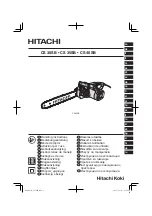
Extension Cords
• Make sure your extension cord is in good condition. When
using an extension cord, be sure to use one heavy enough
to carry the current your product will draw. An undersized
cord will cause a drop in line voltage resulting in loss of
power and overheating. Table 1 shows the correct size
to use depending on cord length and nameplate Ampere
rating. If in doubt, use the next heavier gauge. The smaller
the gauge number, the heavier the cord.
• Ground Fault Circuit Interrupter (GFIC) protection should
be provided on the circuits or outlets to be used for this
Pole Saw. Receptacles are available having built-in GFIC
protection and maybe used for this measure of safety.
• Use only UL listed extension cords. Inspect extension
cord before use and never use damaged or altered
extension cords. Follow extension cord manufacturer
safety instructions.
• To reduce the risk of disconnection of appliance cord from
the extension cord during operating use the plug-receptacle
retaining straps provide or make a knot with the two cords
as shown in Table 2.
• Do not abuse the cord. Never use the cord to carry
the tools or pull the plug from the outlet.
• Keep cord away from heat, oil, sharp edges or moving
parts. Replace damaged cords immediately. Damaged
cords increase the risk of electrical shock.
Table 1. Minimum Recommended Extension Cord Gauge
(AWG) Chart
Table 2. Method of securing Extension Cord
Specific Safety Rules For
Pole Saw
m
WARNING!
Shock Hazard. To protect yourself from electrocution do not
operate saw within 50 feet of overhead wires. Failure to do so
could result in personal injury.
While Operating Pole Saw
• Stay alert. Use common sense while operating the unit.
• Keep work area clean. Cluttered areas invite injuries.
• Be aware of extension cord while operating Pole Saw. Be
careful not to trip over the cord.
• Keep the cord away from the chain and the operator at all
times.
• Keep children, animals, and bystanders away from Pole
Saw and extension cord.
• Only Pole Saw operator should be in work area.
• Do not use the Pole Saw to cut down trees.
• Do not use near power lines. Keep at least 50 feet away
from electrical lines.
• Grip Pole Saw securely with one hand on the trigger, the
other on the pole.
• Before starting Pole Saw, make sure chain is not in contact
with anything.
• Do not allow the Pole Saw to become in contact with
grounded objects such as pipes, fences, and metal posts.
• Keep all parts of body away from chain when Pole Saw
is running.
• Do not force Pole Saw while cutting. Apply light pressure.
It will perform better and more safely at the rate for which it
was intended.
• When cutting a limb that is under tension, use extreme
caution. Be alert that the wood may spring after it is cut.
When wood tension is released, limb could spring back
and strike operator causing severe injury or death.
• Carry Pole Saw from one place to another with unit
unplugged; holding the pole at its balance point
(close to saw end), with guide bar and chain to rear.
• Do not cut small brush and saplings with the Pole Saw.
Small branches may catch in the chain and be whipped
towards the operator and could pull the operator off
balance.
25
18
18
14
14
50
16
16
14
12
100
16
14
14
150
14
12
12
Volts
120V
1 – 5
6 – 10
10 – 12
12 – 16
Total length of cord in feet
AWG
(Extension Cord Gauge)
Not Recommended
Ampere Rating
(B) Connect plug and receptacle
Cord set
Appliance cord
(A) Tie cord as shown
2






























